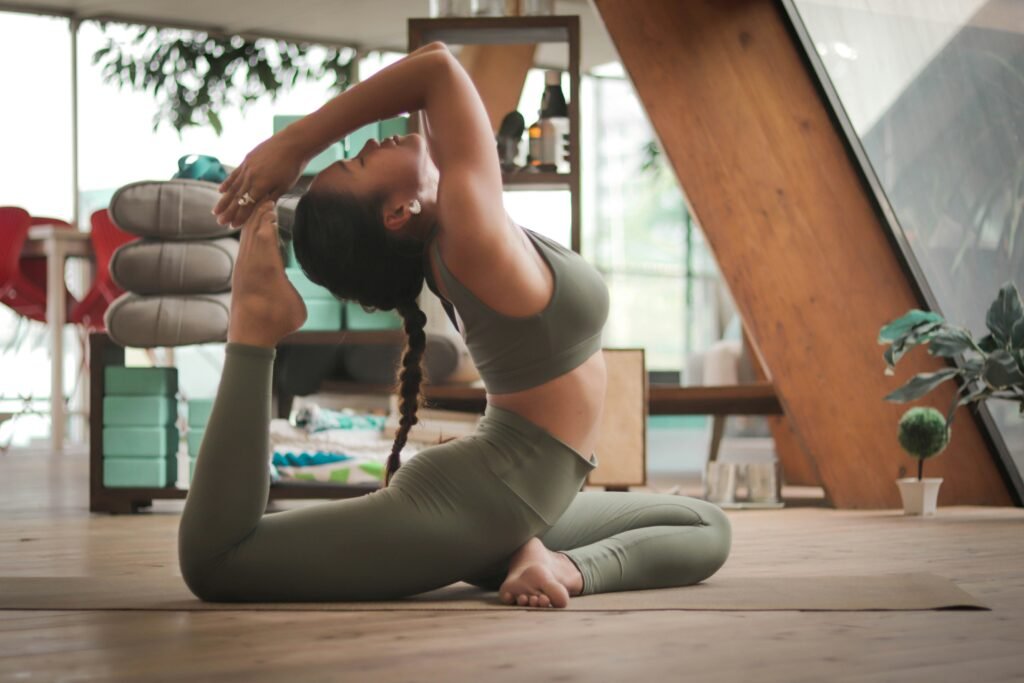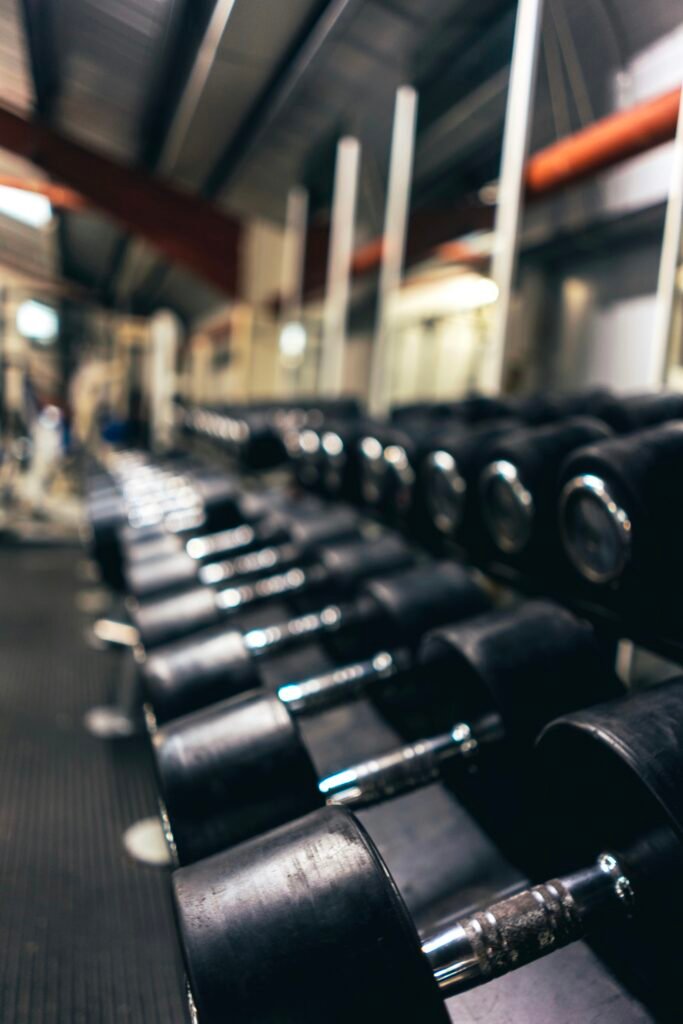Are you a beginner looking to start your fitness journey from the comfort of your own home? Look no further! This article provides you with a comprehensive guide on effective beginner-friendly exercise routines that you can easily incorporate into your daily routine. Whether you’re aiming to increase your strength, flexibility, or cardiovascular endurance, these home workout routines are designed to cater to your needs and help you achieve your fitness goals. So, grab your workout mat, put on your favorite workout clothes, and get ready to embark on a journey of wellness and self-improvement right in the comfort of your own living room.

This image is property of images.unsplash.com.
Yoga
Benefits of Yoga for Beginners
Yoga is a highly beneficial practice for beginners, offering a wide range of physical, mental, and emotional benefits. Through regular practice, you can experience increased flexibility, improved strength, and enhanced balance. Yoga also helps to reduce stress and anxiety, promoting a sense of inner peace and well-being. Additionally, it can enhance your body awareness and mindfulness, allowing you to connect with your breath and stay present in the moment. With its gentle movements and emphasis on self-care, yoga is the perfect exercise for beginners.
Basic Yoga Poses for Beginners
When starting a yoga practice, it’s essential to begin with basic poses that are suitable for beginners. These poses focus on building strength, flexibility, and balance in a gentle and accessible manner. Some fundamental yoga poses for beginners include Mountain Pose, Downward Facing Dog, Warrior I and II, Child’s Pose, and Cat-Cow Pose. These poses provide a solid foundation for your yoga practice and help you develop proper alignment and body awareness. As a beginner, it’s important to listen to your body and only go as far as feels comfortable for you.
How to Start a Home Yoga Practice
Starting a home yoga practice is a fantastic way to incorporate the benefits of yoga into your daily routine. To begin, set aside a dedicated space in your home where you can practice without distractions. Gather essential equipment such as a yoga mat, blocks, and a bolster if needed. Start with a short routine, around 15-20 minutes, and gradually increase the duration as you become more comfortable. Use online tutorials or join virtual yoga classes to guide you through your practice. Remember to listen to your body, take breaks when needed, and always honor your limits.
Pilates
Benefits of Pilates for Beginners
Pilates is another excellent exercise option for beginners, offering a wide range of benefits for both the body and mind. Regular practice can help improve overall strength, flexibility, and posture. It also focuses on core stability, which can improve your balance and help alleviate back pain. Pilates is a low-impact exercise that targets specific muscle groups, making it ideal for beginners who want to strengthen their bodies without putting excessive strain on their joints. Furthermore, it promotes mindful movement, enhancing body awareness and concentration.
Basic Pilates Exercises for Beginners
When starting a Pilates practice as a beginner, it’s important to master the basic exercises before progressing to more advanced ones. Some foundational Pilates exercises include the Hundred, Roll Up, Single-Leg Circles, Plank, and Bridge. These exercises target different muscle groups and provide a solid foundation for building strength and stability. Remember to focus on proper alignment, breathing, and engaging your core muscles throughout each movement. As a beginner, it’s also beneficial to seek guidance from an experienced instructor to ensure you are performing the exercises correctly.
Creating a Pilates Routine at Home
Creating a Pilates routine at home allows you to enjoy the benefits of this exercise form at your convenience. Designing a routine involves selecting a variety of Pilates exercises that target different muscle groups. Aim for a well-rounded routine that includes exercises for the core, arms, legs, and back. You can find instructional Pilates videos or join virtual classes to guide you through your at-home routine. Remember to start with a warm-up, progress through the exercises with proper form, and conclude with a cool-down stretch. Gradually increase the intensity and duration of your Pilates practice as you gain strength and confidence.

This image is property of images.unsplash.com.
Bodyweight Exercises
Benefits of Bodyweight Exercises for Beginners
Bodyweight exercises are an excellent choice for beginners, requiring no equipment and utilizing your own body weight as resistance. These exercises are highly effective for building strength, improving endurance, and increasing overall fitness level. They can be modified to match your current fitness level, allowing you to progress at your own pace. Bodyweight exercises also help improve balance, coordination, and flexibility. Furthermore, they can be done anywhere, making them a convenient option for home workouts or when traveling.
Effective Bodyweight Exercises for Beginners
There is a wide range of bodyweight exercises that beginners can incorporate into their workout routine. Some effective exercises for beginners include squats, lunges, push-ups, planks, and glute bridges. These exercises target multiple muscle groups and can be modified to match your current fitness level. Start with a lower number of repetitions and gradually increase as you build strength and endurance. It’s essential to maintain proper form and engage the correct muscles during each exercise. If needed, seek guidance from a fitness professional to ensure you are performing the exercises correctly.
Designing a Bodyweight Workout Plan
Designing a bodyweight workout plan allows you to create a structured routine that targets different muscle groups and gradually increases in intensity. Begin by selecting a variety of bodyweight exercises that target your upper body, lower body, and core. Aim to perform two to three sets of each exercise with a specific number of repetitions. As a beginner, it’s crucial to focus on proper form and technique before increasing the number of sets or repetitions. Gradually progress your workout plan by adding more challenging exercises and increasing the intensity as you become stronger.
Cardio Workouts
Benefits of Cardio Workouts for Beginners
Cardiovascular exercise, also known as cardio, offers numerous benefits for beginners. Regular cardio workouts help improve heart health, increase endurance, and burn calories, aiding in weight management. It also helps reduce the risk of chronic diseases such as heart disease, diabetes, and certain types of cancer. Cardio promotes the release of endorphins, which can elevate mood, reduce stress, and boost overall mental well-being. Engaging in cardio activities also improves lung function, increases stamina, and enhances overall fitness level.
Low-Impact Cardio Exercises for Beginners
For beginners, low-impact cardio exercises are a great option as they minimize stress on your joints while still providing an effective workout. Walking, cycling, swimming, and using an elliptical machine are among the low-impact cardio exercises suitable for beginners. These exercises are gentle on the body while still providing cardiovascular benefits. Aim for at least 150 minutes of moderate-intensity cardio every week, gradually increasing the duration and intensity as your fitness level improves. Remember to warm up before each session and cool down afterward to prevent injury and promote recovery.
Creating a Cardio Routine at Home
Creating a cardio routine at home allows you to engage in cardiovascular exercise without the need for expensive equipment or a gym membership. Choose activities that you enjoy and can easily incorporate into your daily routine. If you have limited space, jump rope, jogging in place, or dancing can be great options. Online workout videos or virtual classes can guide you through cardio workouts tailored for beginners. Start with shorter sessions and gradually increase the duration and intensity as you progress. Remember to listen to your body and take breaks when needed.

This image is property of images.unsplash.com.
Strength Training
Benefits of Strength Training for Beginners
Strength training is a crucial component of a well-rounded fitness routine, offering a variety of benefits for beginners. It helps build lean muscle mass, which increases metabolism, burns more calories, and aids in weight management. Strength training also enhances bone density, reducing the risk of osteoporosis, and improves overall body composition. It promotes functional fitness, making everyday activities easier to perform. Strength training also improves joint stability, flexibility, and balance, reducing the risk of injury and improving overall quality of life.
Essential Strength Training Exercises for Beginners
If you’re new to strength training, it’s important to start with a few essential exercises that target major muscle groups. Some essential strength training exercises for beginners include squats, lunges, push-ups, chest presses, rows, and bicep curls. These exercises can be performed with either bodyweight or light dumbbells, depending on your current fitness level. Always prioritize proper form and technique over the amount of weight lifted. Seek guidance from a qualified fitness professional to ensure you are performing the exercises correctly and safely.
Building a Strength Training Program at Home
Building a strength training program at home allows you to incorporate this important component of fitness into your routine. Start by selecting a variety of exercises that target different muscle groups. Aim to perform two to three sets of each exercise with a specific number of repetitions. As a beginner, it’s important to start with lighter weights or bodyweight exercises and progress gradually as you become stronger. Allow for proper rest between sets and focus on proper form and technique. Consider investing in a set of dumbbells or resistance bands for added resistance.
HIIT (High-Intensity Interval Training)
Benefits of HIIT for Beginners
High-Intensity Interval Training, or HIIT, provides numerous benefits for beginners seeking an efficient and effective workout. HIIT workouts typically involve short bursts of intense exercise followed by periods of active recovery. This form of exercise helps boost cardiovascular fitness, improve endurance, and burn calories. HIIT workouts are time-efficient, allowing you to maximize results in a shorter amount of time compared to traditional steady-state cardio. Furthermore, HIIT can elevate your metabolism, leading to continued calorie burn even after your workout is completed.
Beginner-Friendly HIIT Exercises
As a beginner, it’s important to choose HIIT exercises that are suitable for your fitness level and limit the risk of injury. Some beginner-friendly HIIT exercises include jumping jacks, high knees, mountain climbers, squat jumps, and burpees. These exercises can be modified to match your current fitness level by reducing the intensity or impact. Start with shorter intervals of high-intensity exercise followed by longer periods of rest or active recovery. As you progress, gradually increase the intensity and duration of your HIIT intervals.
Designing a HIIT Workout Plan
Designing a HIIT workout plan allows you to create a structured routine that incorporates a variety of exercises and intervals. Begin by selecting a few different exercises that target multiple muscle groups. Determine the duration and intensity of each interval, as well as the duration of rest or active recovery periods. Aim for a total workout duration of around 20-30 minutes, including warm-up and cool-down. As a beginner, it’s important to start with shorter intervals and gradually increase the duration and intensity as you become more comfortable and fit.
Stretching and Flexibility
Importance of Stretching for Beginners
Stretching is a crucial component of any exercise routine, especially for beginners. It helps improve flexibility, joint range of motion, and overall mobility. Stretching also reduces muscle tension, improves posture, and enhances athletic performance. Additionally, stretching promotes relaxation, relieves stress, and improves circulation. Regular stretching can prevent muscle imbalances, enhance recovery, and reduce the risk of injury during exercise. It’s important to include both dynamic stretches before exercise and static stretches after exercise in your routine.
Basic Stretches for Beginners
When starting a stretching routine as a beginner, it’s important to focus on basic stretches that target major muscle groups. Some basic stretches for beginners include calf stretches, hamstring stretches, quadriceps stretches, chest stretches, and shoulder stretches. Hold each stretch for 20-30 seconds, allowing your muscles to relax and elongate. Breathe deeply and avoid bouncing or jerking movements. Always stretch within your comfort zone, feeling a gentle pull and avoiding any pain or discomfort. Consult with a qualified fitness professional if you have any specific concerns or limitations.
Incorporating Stretching into Your Daily Routine
Incorporating stretching into your daily routine is essential for maintaining flexibility and preventing muscle imbalances. Find a time during the day when you can dedicate a few minutes to stretching. It could be in the morning to wake up your body, during breaks at work to combat the effects of sitting, or before bed to promote relaxation. Choose a variety of stretches that target different muscle groups and hold each stretch for 20-30 seconds. Gradually increase the duration and intensity of your stretches as your flexibility improves.
Warm-Up Exercises
Why Warm-Up Exercises are Important for Beginners
Warm-up exercises are a crucial part of any exercise routine, especially for beginners. They help prepare your body for the upcoming workout by increasing your heart rate, blood flow, and body temperature. A good warm-up also activates the muscles you will be using during the workout, enhancing their flexibility and preventing injury. Warm-up exercises help mentally prepare you for the workout ahead and improve overall performance. By increasing circulation and loosening up your joints, warm-up exercises ensure you are ready to engage in more intense physical activity safely.
Effective Warm-Up Exercises for Beginners
Effective warm-up exercises for beginners should focus on gently increasing heart rate and warming up major muscle groups. Some effective warm-up exercises include jogging in place, jumping jacks, arm circles, hip circles, and side lunges. Perform each exercise for around 30 seconds to one minute, gradually increasing the intensity as you progress through your warm-up routine. Remember to breathe deeply and listen to your body. If you experience any pain or discomfort, modify or skip certain exercises. Always prioritize safety and ensure you are properly warmed up before moving on to your main workout.
Tips for a Proper Warm-Up Routine
To ensure a proper warm-up routine, start with 5-10 minutes of low-intensity cardio exercises such as walking or light jogging. This helps elevate your heart rate and increases blood flow to your muscles. Follow this with dynamic stretches that target major muscle groups, such as leg swings or shoulder rolls. Perform a few mobility exercises to activate specific muscle groups targeted in your workout. Finally, practice movements that mimic the exercises you will be performing during the main workout. This helps prepare your mind and body for the upcoming activity. Always listen to your body and modify as needed during the warm-up.
Cool-Down Exercises
Why Cool-Down Exercises are Important for Beginners
Cool-down exercises are an essential part of any exercise routine, providing a gradual transition from the workout back to a resting state. They help lower heart rate and cool down body temperature. Cool-down exercises also aid in the removal of waste products such as lactic acid, reducing the risk of muscle soreness and fatigue. By incorporating cool-down exercises into your routine, you can promote muscle recovery, enhance flexibility, and improve overall well-being. Cool-down exercises provide a soothing and relaxing end to your workout, allowing both your body and mind to recover.
Relaxing Cool-Down Exercises for Beginners
Relaxing cool-down exercises for beginners focus on gently stretching and lengthening major muscle groups while promoting relaxation and reducing tension. Some relaxing cool-down exercises include forward folds, seated or supine twists, child’s pose, and gentle walking or cycling. Hold each stretch for 30-60 seconds, focusing on deep breathing and releasing any tension or tightness in your muscles. Allow your heart rate to gradually return to normal and your body to enter into a state of calm and relaxation. Make sure to listen to your body and only stretch within your comfort zone.
Tips for a Proper Cool-Down Routine
To ensure a proper cool-down routine, aim to spend at least 5-10 minutes on gentle activities that gradually reduce your heart rate and relax your muscles. Start with a few minutes of slow walking or light cycling to slowly bring your heart rate down. Follow this with static stretches that target major muscle groups, holding each stretch for 30-60 seconds. Focus on deep breathing and allow yourself to fully relax into each stretch. Avoid any bouncy movements or forceful stretching. Listen to your body and adjust stretches as needed to prevent any discomfort or pain.
Finding Motivation and Staying Consistent
Setting Realistic Goals for Beginner Exercise Routines
When starting an exercise routine as a beginner, it’s important to set realistic goals that are achievable and sustainable. Set specific goals that are tailored to your personal needs and desires. Start with small, measurable goals that you can work towards in a reasonable timeframe. Celebrate your progress along the way, and don’t be discouraged if you experience setbacks. Focus on the process rather than solely on the outcome and remember that consistency is key. By setting realistic goals, you can maintain your motivation and gradually build a long-lasting exercise routine.
Creating a Schedule and Tracking Progress
Creating a schedule and tracking your progress can help you stay motivated and accountable to your exercise routine. Plan your workouts in advance and schedule them at times that fit into your daily routine. Treat your exercise sessions as non-negotiable appointments with yourself. Keep a workout journal or use fitness tracking apps to record your workouts, including the exercises performed, duration, intensity, and any notes or observations. Track your progress by setting benchmarks or periodically reassessing your fitness level. Seeing how far you’ve come can provide a boost of motivation to keep going.
Maintaining Motivation and Overcoming Obstacles
Maintaining motivation and overcoming obstacles during your fitness journey can be challenging, but it’s essential for long-term success. Find an exercise routine that you enjoy and matches your interests and preferences. Vary your workouts to keep them engaging and prevent boredom. Stay flexible and adjust your routine when life gets busy or unexpected obstacles arise. Remind yourself of your reasons for starting and the positive benefits you’ve experienced so far. Surround yourself with a supportive community or enlist a workout buddy to keep you motivated. Remember that progress takes time, and every step counts towards your overall well-being.
